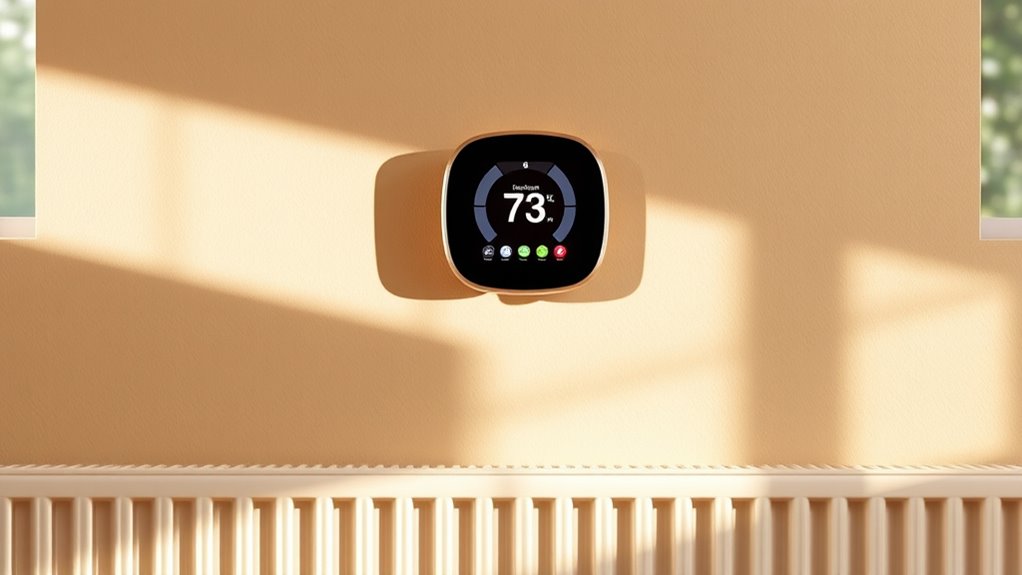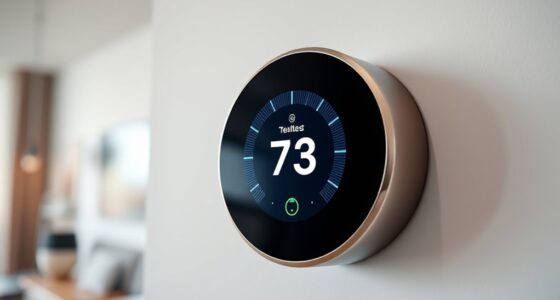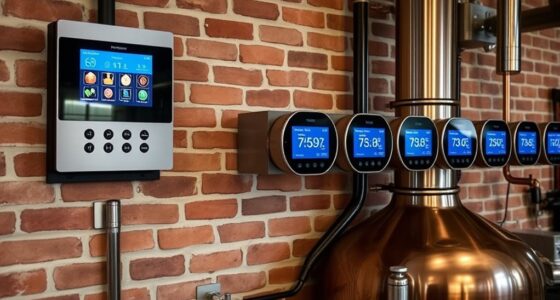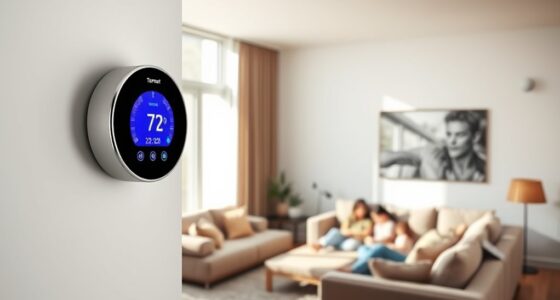If you’re looking to upgrade your baseboard heating, I recommend checking out smart thermostats like Mysa, meross, and MOES. These models support high-voltage systems, are easy to install, and offer features like remote control, voice commands, and energy savings. They’re perfect for keeping your home cozy and efficient. Want to discover which options fit your needs best? Keep exploring to find the ideal thermostat for your setup.
Key Takeaways
- Compatibility with 120V/240V high-voltage baseboard heating systems is essential for effective control.
- Features like precise temperature regulation, scheduling, and energy-saving modes enhance comfort and efficiency.
- Easy DIY installation with clear wiring instructions ensures quick setup and reliable operation.
- Integration with voice assistants (Alexa, Google, HomeKit) allows seamless remote control and automation.
- Safety features such as GFCI protection and reliable connectivity ensure long-term, safe use.
Mysa Smart Thermostat LITE for Electric Baseboard Heaters
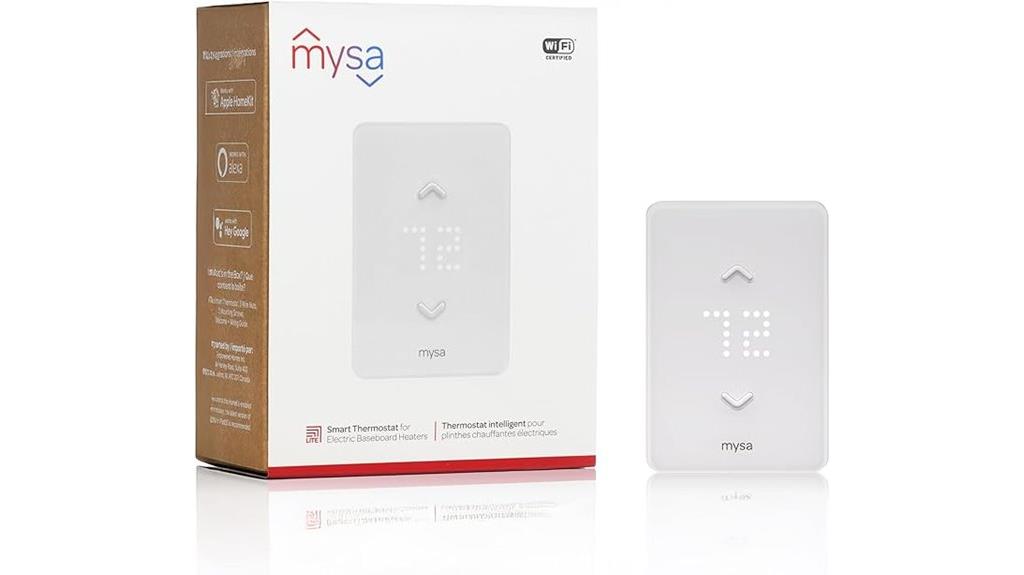
If you have high-voltage electric baseboard heaters and want a straightforward, reliable way to control them remotely, the Mysa Smart Thermostat LITE is an excellent choice. It’s compatible with 120-240V systems, including baseboards and fan-forced heaters, but requires at least four wires, including a neutral or second live wire. The thermostat connects via Wi-Fi, letting you control your heating from anywhere using the free mobile app. It supports voice control through HomeKit, Alexa, and Google Home, and offers easy DIY installation with helpful guides. Plus, its scheduling feature can help you save up to 26% on energy costs.
Best For: homeowners with high-voltage electric baseboard or fan-forced heaters seeking a reliable, Wi-Fi-enabled thermostat for remote control and energy savings.
Pros:
- Compatible with 120-240V high/line voltage systems including baseboards and fan-forced heaters
- Supports remote control and automation via free mobile app and voice assistants (HomeKit, Alexa, Google Home)
- Easy DIY installation with step-by-step video guides and expert support
Cons:
- Requires a minimum of four wires, including a neutral or second live wire, which may limit compatibility with older systems
- Does not support low-voltage or two-wire installations
- Optimized for 2.4 GHz Wi-Fi networks, potentially less effective on only 5 GHz networks
meross Smart Thermostat for Electric Baseboard and In-Wall Heaters

The meross Smart Thermostat stands out as an excellent choice for those seeking easy-to-install, high-compatibility control for electric baseboard and in-wall heaters. It installs in under 30 minutes and works with various high-voltage systems up to 16A, 1920W at 120V, and 3840W at 240V. It supports voice commands through Siri, Alexa, and Google Assistant, making hands-free adjustments simple. The sleek LCD display allows precise temperature control from 41°F to 95°F, while the app offers customizable schedules and energy monitoring. Plus, its open window detection helps save energy by temporarily halting heating when ventilation is detected.
Best For: homeowners or renters looking for an easy-to-install, high-compatibility smart thermostat to control electric baseboard and in-wall heaters with energy-saving features and voice control options.
Pros:
- Easy installation under 30 minutes with broad compatibility for high-voltage electric heaters
- Supports multiple voice assistants including Siri, Alexa, and Google Assistant for hands-free control
- Offers precise temperature regulation with a sleek LCD display and customizable scheduling
Cons:
- Requires at least 4 wires in the electric box, potentially limiting compatibility in some setups
- Electric baseboard heaters are not included, requiring separate purchase
- Maximum load capacity of 16A may not suit larger heating systems
MOES Programmable Smart Thermostat for Electric Baseboard Heaters

The MOES Programmable Smart Thermostat is an excellent choice for homeowners with electric baseboard heaters who want reliable, remote control over their heating systems. It supports 120V/240V systems and connects seamlessly to 2.4G WiFi, allowing me to control my heater via the Smart Life or TUYA app from anywhere. With compatibility for Alexa and Google Home, I can use voice commands for convenience. The thermostat features a sleek, modern design with a frosted display and tactile knob for manual adjustments. Installation is straightforward, requiring at least four wires, and the device helps save energy by enabling scheduling that reduces costs up to 23%.
Best For: homeowners with electric baseboard heaters seeking a reliable, easy-to-use smart thermostat with remote control and voice command compatibility.
Pros:
- Supports 120V/240V systems, making it versatile for various setups
- Seamless WiFi connectivity with Smart Life/TUYA app for remote control from anywhere
- Modern design with frosted display and tactile knob for easy manual adjustments
Cons:
- Requires at least four wires in the electrical box, including neutral or second live wire, which may not be available in all installations
- Installation may be straightforward but still requires basic electrical knowledge or professional help
- Limited to electric baseboard heaters; not compatible with other types of heating systems
Mysa Smart Thermostat for Electric In-Floor Heating
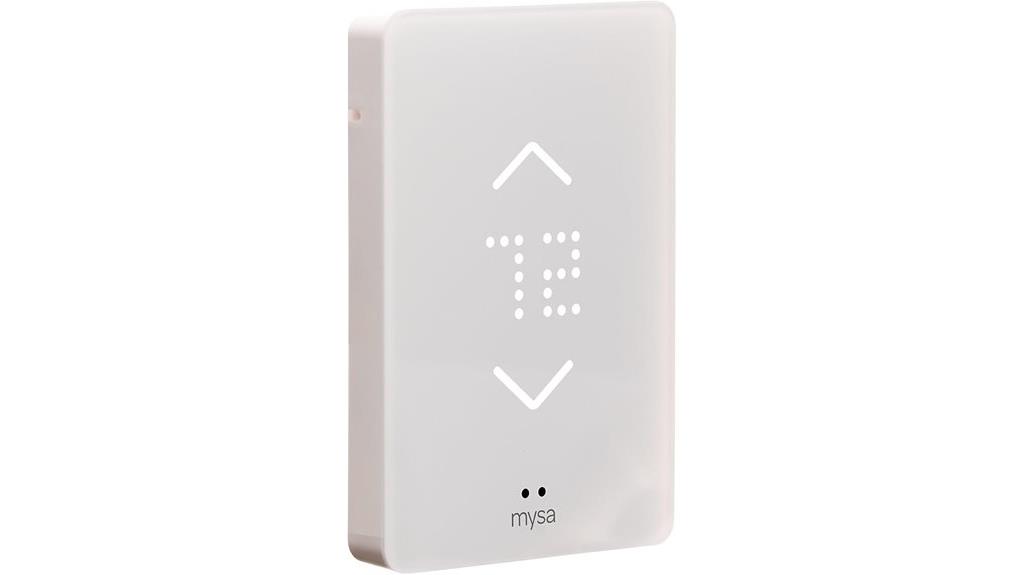
For homeowners with electric in-floor heating, the Mysa Smart Thermostat stands out as an excellent choice due to its Wi-Fi connectivity and compatibility with popular voice assistants like HomeKit, Alexa, and Google Home. I appreciate its remote control feature via a free app, making it easy to adjust settings from anywhere. Installation is straightforward, and it’s designed specifically for high-voltage systems (120-240V). Plus, the built-in Class A GFCI guarantees safety. With a 2-year warranty when bought from an authorized seller, Mysa offers peace of mind and modern smart control for a cozy, efficient home.
Best For: homeowners seeking a smart, safe, and easy-to-install thermostat for electric in-floor heating with voice control and remote access.
Pros:
- Compatible with popular voice assistants like HomeKit, Alexa, and Google Home for seamless smart home integration
- Built-in Class A GFCI enhances safety during operation
- Easy to install and operate via free app without subscription fees
Cons:
- Not compatible with hydronic or water-based heating systems
- Limited to high/line voltage systems (120-240V), so incompatible with lower-voltage setups
- Requires Wi-Fi connectivity, which may be a concern in areas with poor internet access
Honeywell Home Programmable Thermostat for Electric Baseboard Heaters

If you’re looking for an affordable, reliable solution to control electric baseboard heaters with precise scheduling, the Honeywell Home Programmable Thermostat is an excellent choice. It’s compatible with 120V or 240V systems and easy to install with a simple 2-wire connection. This digital thermostat offers accurate temperature control within ±0.27°F and operates silently thanks to TRIAC switching technology. You can program separate schedules for weekdays and weekends, and features like vacation mode and manual override make it flexible. Built for durability and long-term use, it’s a cost-effective way to keep your home cozy and energy-efficient.
Best For: homeowners seeking an affordable, reliable, and easy-to-install programmable thermostat for controlling electric baseboard heaters with precise scheduling.
Pros:
- Accurate temperature control within ±0.27°F for comfort and efficiency
- Easy 2-wire installation suitable for DIY replacements
- Silent operation with TRIAC switching technology reduces temperature swings
Cons:
- Small display screen may be challenging for some users to read easily
- No OFF mode; manual mode maintains constant temperature without scheduling flexibility
- Programming can have a slight learning curve for first-time users
Wi-Fi Smart Thermostat for Electric Baseboard Heaters
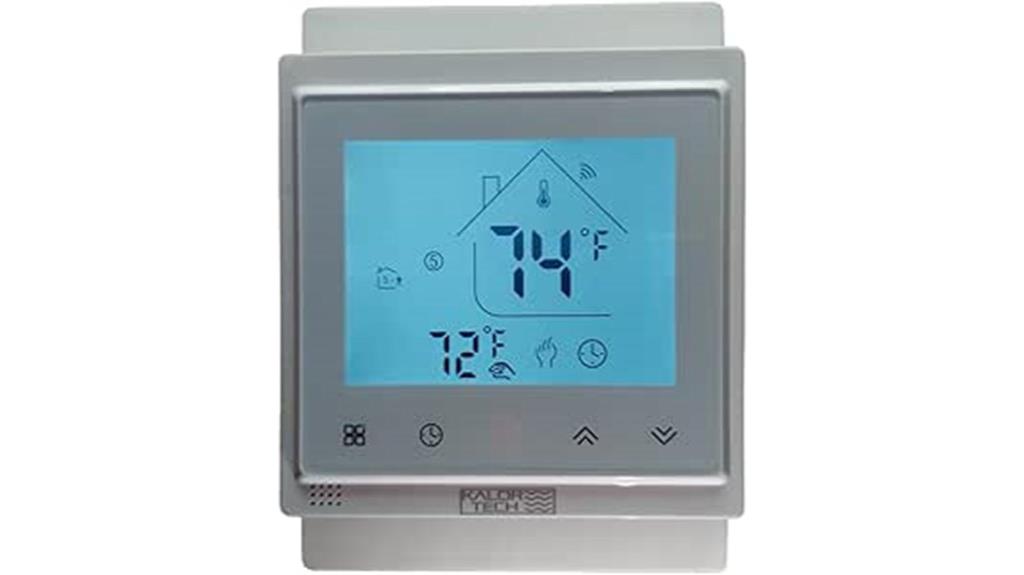
A Wi-Fi smart thermostat designed for electric baseboard heaters is an excellent choice for homeowners seeking remote control and customizable scheduling. It supports 120-240V systems and features a sleek, square design with a proprietary wall plate for easy installation. You can control it via touchscreen, voice commands, or through apps like Alexa, Google Home, and Tuya. The thermostat allows you to set personalized schedules and manage your heating from anywhere, making it ideal for rentals or vacation homes. While some users note minor installation and accuracy issues, overall, it provides a budget-friendly, convenient way to keep your home cozy and efficient.
Best For: homeowners and renters seeking a budget-friendly, Wi-Fi-enabled thermostat for electric baseboard heaters with remote control and scheduling capabilities.
Pros:
- Supports 120V and 240V systems, offering versatile compatibility
- Easy to install with included components and app control for convenience
- Voice control integration with Alexa, Google Home, and app compatibility for hands-free operation
Cons:
- Temperature readings may be inaccurate and adjustments can revert over time
- Installation can be challenging due to fit issues and unclear instructions
- Display remains lit briefly, which some users find frustrating
Electric Baseboard Heaters Thermostat with LCD Display
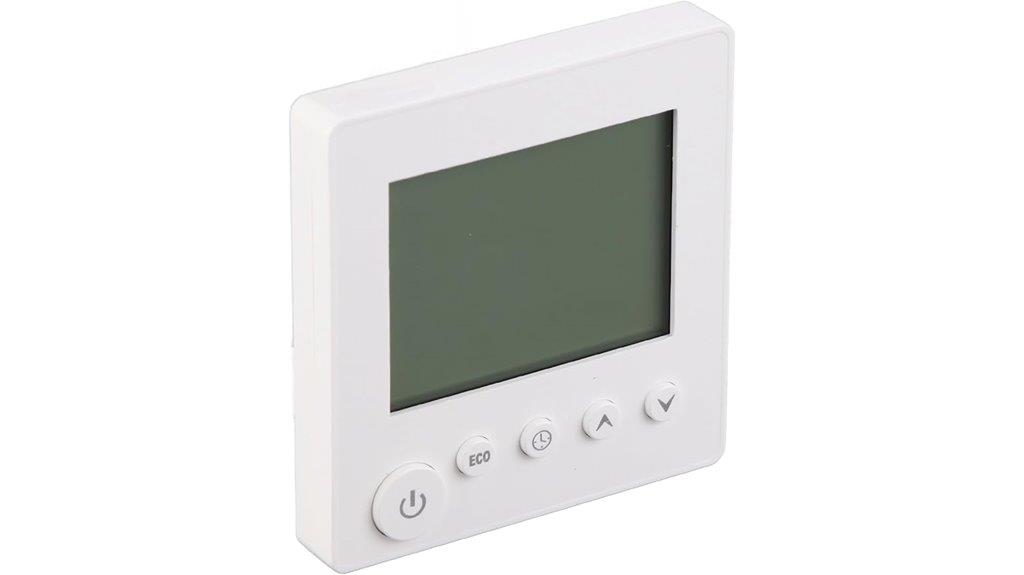
The Electric Baseboard Heaters Thermostat with LCD Display stands out as an ideal choice for homeowners seeking precise and user-friendly control over their electric heating systems. Its programmable function, clear backlit LCD, and app control make adjusting temperatures easy. With a wide measurement range (0–50℃) and adjustable setpoints (5–60℃), it offers high accuracy within ±1℃. Designed mainly for underfloor heating, it may face compatibility issues with some baseboard heaters. Installation is straightforward with included screws and wiring harness. Despite mixed reviews on customer support and compatibility, its modern style and precise sensors make it a solid option for efficient heating management.
Best For: homeowners seeking precise, programmable control over electric heating systems, especially underfloor heating, with user-friendly features and app compatibility.
Pros:
- High accuracy temperature control within ±1℃, ensuring efficient heating.
- Clear backlit LCD display and app control for easy operation and adjustments.
- Wide temperature measurement (0–50℃) and setpoints (5–60℃) for versatile use.
Cons:
- Compatibility issues reported with some baseboard heaters, requiring verification before purchase.
- Difficulties in connecting external thermocouple wires (1 meter) may limit installation flexibility.
- Mixed customer reviews regarding support, potential defective units, and setup challenges.
Honeywell Home Smart Thermostat

For homeowners seeking a versatile and energy-efficient smart thermostat, the Honeywell Home Smart Thermostat stands out. It supports conventional and heat pump systems, with flexible scheduling and auto-away features to optimize energy use. Compatible with Alexa, Google Assistant, and Apple HomeKit, it offers seamless smart home integration. The device is WiFi-enabled and ENERGY STAR certified, allowing remote control via the First Alert app. Easy to install, it works best with a C-wire and offers customizable display options. With a 2-year warranty, users appreciate its energy-saving capabilities, though some note occasional WiFi connectivity issues. Overall, it’s a reliable choice for a smart, adaptable home heating solution.
Best For: homeowners seeking a versatile, energy-efficient smart thermostat compatible with multiple smart home platforms and heat pump or conventional systems.
Pros:
- Supports a wide range of smart home integrations including Alexa, Google Assistant, and Apple HomeKit
- Offers flexible scheduling and auto-away features to optimize energy efficiency
- Easy to install, especially for existing Honeywell systems, with customizable display options
Cons:
- Occasional WiFi connectivity issues and app update complications reported by users
- Requires a C-wire for optimal performance, which may not be available in all homes
- Customer support experiences vary, with some users citing difficulty in troubleshooting
RLV3120A1005 Digital Non-Programmable Thermostat for Electric Heat Only
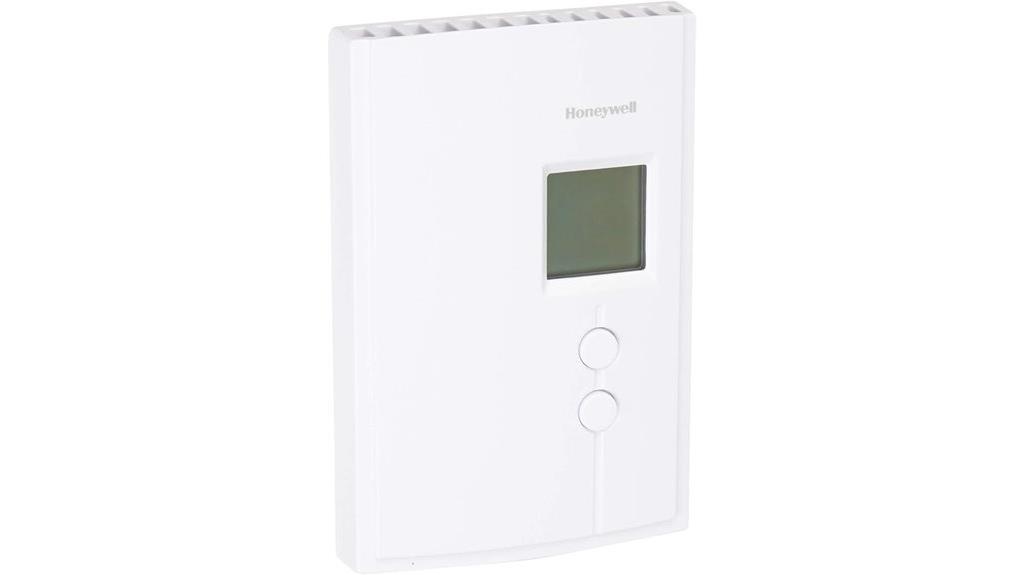
If you’re looking for a straightforward, reliable thermostat for electric baseboard heaters, the Honeywell RLV3120A1005 stands out as a solid choice. It’s a digital, non-programmable model designed specifically for electric heat, with a sleek display, backlight, and simple push-button controls. Rated for up to 2000 watts at 240V, it’s easy to install with just two wires, making it ideal for small spaces or replacing older thermostats. It offers precise temperature control with a ±0.27°F accuracy, silent TRIAC switching, and proportional output levels to guarantee consistent comfort without noise or abrupt temperature swings.
Best For: those seeking a simple, reliable digital thermostat for electric baseboard heaters with easy installation and precise temperature control.
Pros:
- Easy two-wire installation suitable for small spaces or replacing manual thermostats
- Silent TRIAC switching eliminates noise disturbances and provides smooth operation
- Accurate temperature regulation within ±0.27°F, ensuring consistent comfort
Cons:
- Limited to basic on/off or proportional control without advanced programming features
- Plastic buttons may feel less premium and could wear over time
- Compatibility with 240V systems may require careful wiring adjustments to meet electrical codes
ecobee Smart Thermostat Enhanced, Programmable WiFi Thermostat
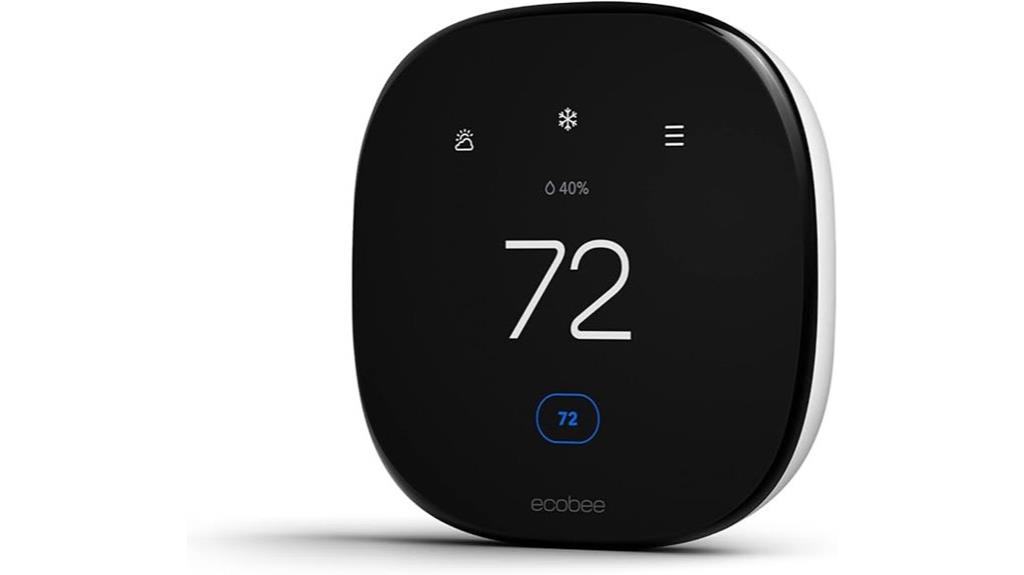
Anyone looking to maximize energy savings and comfort with a smart thermostat will find the ecobee Smart Thermostat Enhanced an excellent choice. It can save up to 26% annually on heating and cooling costs by automatically adjusting temperatures when you’re away and preheating or precooling before you arrive. The thermostat also manages humidity for consistent comfort and uses SmartSensor technology to focus on key rooms. Compatible with major voice assistants and controllable via the ecobee app, it’s easy to operate and install, even without a C-wire. Certified Energy Star, it offers reliable, energy-efficient performance and seamless smart home integration.
Best For: homeowners and renters seeking to maximize energy savings, enhance comfort, and integrate seamlessly with their smart home system.
Pros:
- Saves up to 26% annually on heating and cooling costs through intelligent adjustments.
- Compatible with major voice assistants like Siri, Alexa, and Google Assistant for convenient control.
- Easy to install with options for homes lacking a C-wire and supports various HVAC systems.
Cons:
- May require additional components like the Power Extender Kit for certain installations.
- Advanced features might be complex for users unfamiliar with smart thermostats.
- Some users may experience compatibility issues with less common HVAC setups.
Sensi Smart Thermostat
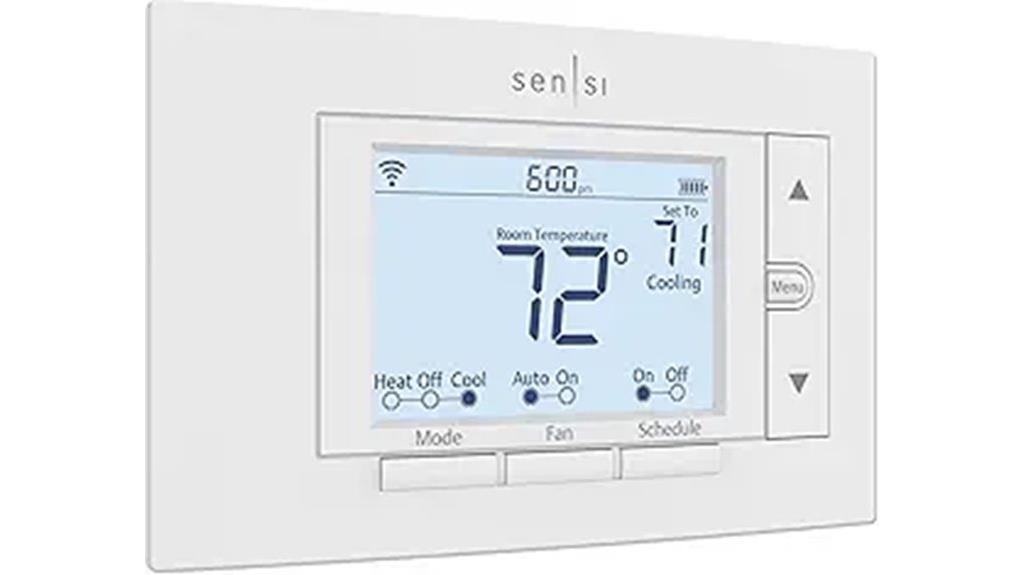
The Sensi Smart Thermostat stands out as an excellent choice for homeowners seeking an easy-to-install, Wi-Fi-enabled thermostat that offers advanced scheduling and remote control features. Its sleek LED display, backlight, and button controls fit seamlessly into standard wall openings, making DIY installation simple without patching or painting. Compatible with most HVAC systems, often without needing a c-wire, it supports voice commands via Alexa, Google Assistant, and others. Energy Star certified, it helps save around 23% on energy bills through scheduling, remote access, and usage reports. Plus, its reliable app and straightforward setup make managing your home’s comfort effortless.
Best For: homeowners seeking an easy-to-install, Wi-Fi-enabled smart thermostat with energy-saving features and voice control compatibility.
Pros:
- Simple DIY installation with minimal patching or painting required
- Compatible with most HVAC systems, often without a c-wire
- Energy Star certified, helping save approximately 23% on energy bills
Cons:
- Limited detailed usage data and insights for energy consumption
- No support for Bixby voice commands
- Occasional connectivity or setting adjustment issues reported by some users
ecobee Smart Thermostat Premium with Sensors and Air Quality Monitor

The ecobee Smart Thermostat Premium with Sensors and Air Quality Monitor stands out for those seeking all-encompassing environmental control and energy savings. It can save up to 26% annually on heating and cooling and is ENERGY STAR certified. The included SmartSensor adjusts temperatures in key rooms, reducing hot and cold spots. It also features a built-in air quality monitor that alerts you to poor air quality and suggests improvements, plus detects sudden temperature drops to prevent damage. The thermostat’s premium design, vibrant display, and advanced occupancy sensing make it user-friendly. Additionally, it functions as a home security hub with smoke detection and integrates seamlessly with voice assistants like Alexa and Siri.
Best For: homeowners seeking comprehensive energy savings, advanced environmental monitoring, and integrated home security features in a stylish, user-friendly smart thermostat.
Pros:
- Up to 26% annual savings on heating and cooling costs, ENERGY STAR certified for efficiency
- Built-in air quality monitor and SmartSensor for personalized comfort and air management
- Acts as a home security hub with smoke detection and compatibility with voice assistants like Alexa and Siri
Cons:
- Requires a separate ecobee Smart Security plan for security features
- Apple Home Hub needed for Siri integration, adding extra setup requirements
- Compatibility limited to 24VAC HVAC systems, which may not suit all homes
Mysa Smart Thermostat for Mini-Split Heat Pumps & AC
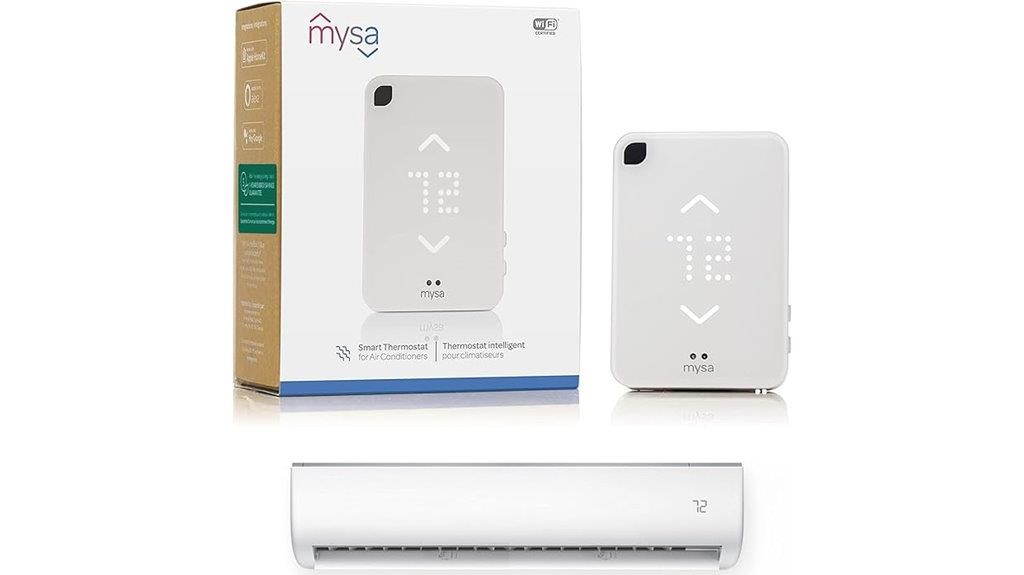
For homeowners with mini-split heat pumps or central AC systems, the Mysa Smart Thermostat stands out as an excellent choice because it replaces remote controls with Wi-Fi programmability. It’s compatible with HomeKit, Alexa, and Google Home, making voice control and automation simple. The sleek wall mount makes installation quick and straightforward, while the free app allows you to monitor and adjust your system remotely. With features like in-app scheduling, geofencing, and smart alerts, you can optimize comfort and save energy. Plus, potential rebates may help offset costs. Mysa’s setup support and safety features ensure a reliable, user-friendly experience to keep your home cozy and efficient.
Best For: homeowners with mini-split heat pumps or central AC systems seeking a smart, easy-to-install thermostat that offers remote control, voice compatibility, and energy-saving features.
Pros:
- Compatible with popular voice assistants like HomeKit, Alexa, and Google Home for seamless automation.
- Easy to install with a sleek wall mount and step-by-step video guidance.
- Offers energy-saving tools such as scheduling, geofencing, and smart alerts to optimize comfort and reduce costs.
Cons:
- Requires a Wi-Fi connection for full functionality, which may be a concern in areas with unreliable internet.
- Limited to mini-split heat pumps and AC systems, not suitable for traditional HVAC setups.
- Potential rebates vary by utility provider and location, so savings are not guaranteed everywhere.
Factors to Consider When Choosing a Smart Thermostat for Baseboard Heaters

When choosing a smart thermostat for baseboard heaters, I consider compatibility with my system and whether the wiring setup supports easy installation. I also look at the smart features available and how they can help me save energy, along with how easy the controls are to use daily. These factors guarantee I get a device that fits my needs and makes managing my home’s heat more efficient.
Compatibility Requirements
Are you sure your smart thermostat is compatible with your baseboard heater’s electrical system? Many electric baseboard heaters operate on high-voltage systems, typically 120-240V, so your thermostat must support this. Additionally, check that your wiring includes at least four wires, like a neutral or second live wire, to guarantee proper function. The thermostat should support line voltage control and not require low-voltage or two-wire setups. It’s also crucial to verify that it can handle the maximum load of your heater, often up to 16A or 1920W at 120V. Lastly, confirm your home’s wiring setup matches the thermostat’s requirements, including proper grounding and wiring standards. Compatibility is key to safe, effective operation and maximum comfort.
Wiring and Installation
Ensuring your wiring setup is compatible with a smart thermostat is essential for a safe and efficient installation. First, check that your system has at least four wires, including a neutral or second live wire, which is necessary for proper operation. Verify that your wiring matches line-voltage thermostats, typically controlling 120V or 240V systems, not low-voltage setups. It’s also important to see if your existing wiring can support features like proportional or on/off control, as some thermostats need specific wiring for advanced functions. Additionally, confirm that your electrical box and wiring length suit the thermostat’s mounting and connection points. Always follow the manufacturer’s installation instructions carefully to avoid wiring errors that could cause malfunctions or safety risks.
Smart Features Offered
Choosing a smart thermostat with the right features can make a significant difference in how effectively you manage your baseboard heaters. Look for models that support remote control and scheduling—these let you customize heating based on your daily routine, saving energy without sacrificing comfort. Compatibility with voice assistants like Alexa, Google Assistant, or Apple HomeKit allows for hands-free operation, making adjustments effortless. Some thermostats have learning capabilities or adaptive algorithms that automatically fine-tune settings for ideal comfort and efficiency. Real-time energy monitoring and detailed usage reports help you track electricity consumption and identify ways to save. Finally, user-friendly mobile apps are essential—they enable easy setup, customization, and control from anywhere, ensuring your home stays cozy and efficient at all times.
Energy Saving Capabilities
Smart thermostats with energy-saving features can substantially reduce your heating costs by optimizing how and when your baseboard heaters operate. Look for models with scheduling options that lower heat during unoccupied periods, saving up to 26% on energy bills. Precise temperature control within 1°F helps prevent over-heating and unnecessary energy use. Thermostats with adaptive or learning algorithms can analyze your habits and adjust heating patterns for maximum efficiency. Energy monitoring capabilities provide real-time data on consumption, allowing you to identify waste. Additionally, features like open window detection or ventilation sensors can automatically turn off heating when airflow is detected, further reducing wasted energy. Prioritizing these capabilities guarantees your home stays cozy while keeping your energy costs in check.
Usability and Controls
When selecting a smart thermostat for your baseboard heaters, it’s important that the device offers intuitive control options. I recommend choosing models with user-friendly interfaces like touchscreens, manual buttons, or app-based controls, so you can easily adjust settings without hassle. Voice command support through platforms like Alexa, Google Assistant, or Siri adds convenience, allowing for hands-free operation. Precise temperature regulation—within 1°F—is key to maintaining consistent comfort. Look for thermostats with customizable scheduling features to automate your heating routines around your daily schedule. Additionally, controls should be straightforward to program, especially if you’re not tech-savvy. A well-designed interface makes setup and adjustments simple, ensuring you get the comfort and efficiency you want without frustration.
Frequently Asked Questions
Can These Thermostats Be Controlled Remotely via Smartphone Apps?
Absolutely, many smart thermostats can be controlled remotely through smartphone apps. I love how I can adjust the temperature from anywhere, whether I’m at work or on vacation. These apps are usually user-friendly and offer features like scheduling and energy reports. It’s so convenient to have control at my fingertips, ensuring my home stays cozy and efficient no matter where I am.
Do Smart Thermostats Work With All Types of Baseboard Heaters?
When wondering if smart thermostats work with all types of baseboard heaters, I’d say it depends. Some models are compatible, especially with electric baseboards, while others might need additional wiring or smart relay switches. I always advise double-checking your heater’s make and model. Compatibility can be tricky, but with a little research, I’ve found it’s possible to make most baseboard heaters smarter, safer, and more efficient.
Are Installation Services Included or Diy-Friendly for These Thermostats?
You’re wondering if installation services come with smart thermostats or if they’re DIY-friendly. I find that many thermostats are designed for easy installation, so if you’re comfortable with basic wiring, you can often set them up yourself. However, some models or complex setups might require professional help. I recommend checking each product’s instructions or contacting a technician to guarantee a smooth, safe installation process.
How Do Smart Thermostats Improve Energy Efficiency Compared to Traditional Models?
Smart thermostats boost energy efficiency by learning my schedule and adjusting heating accordingly, so I don’t waste energy when I’m not home or sleeping. They also let me control temperature remotely, preventing unnecessary heating. Unlike traditional models, they provide detailed energy reports, helping me identify ways to save. Overall, they’re smarter, more responsive, and save me money by optimizing my home’s heating without sacrificing comfort.
Do These Thermostats Support Integration With Home Automation Systems?
Think of smart thermostats as the maestros of home automation—they can coordinate with various systems seamlessly. Most support integration with popular platforms like Alexa, Google Assistant, and Apple HomeKit, turning your home into a symphony of convenience. I’ve found that choosing a thermostat compatible with your existing smart system not only simplifies control but also enhances your home’s overall intelligence and comfort.
Conclusion
Choosing the right smart thermostat for your baseboard heaters is like tuning a finely crafted instrument—you want perfect harmony between comfort and efficiency. With options tailored to various needs, you can find the right fit to keep your home cozy while saving energy. Remember, the right thermostat is the conductor that orchestrates a warm, inviting space, making every room a harmonious refuge from the chill outside.
